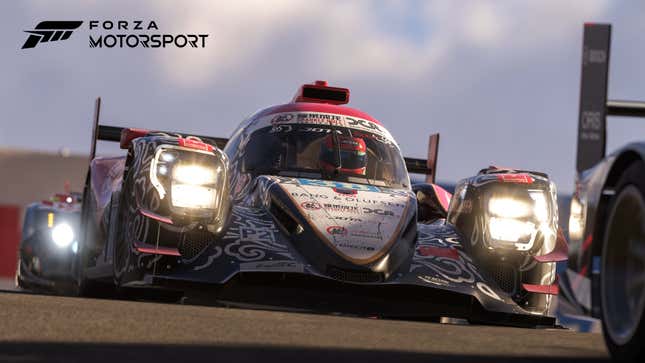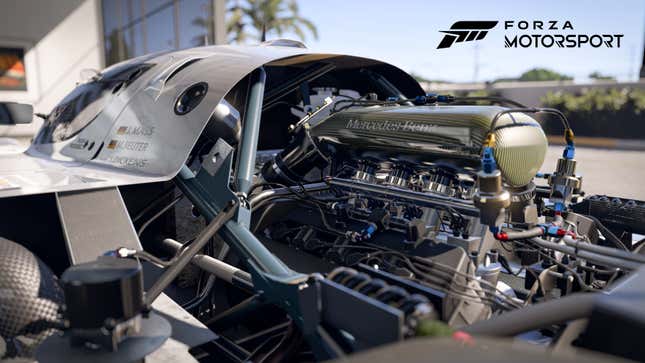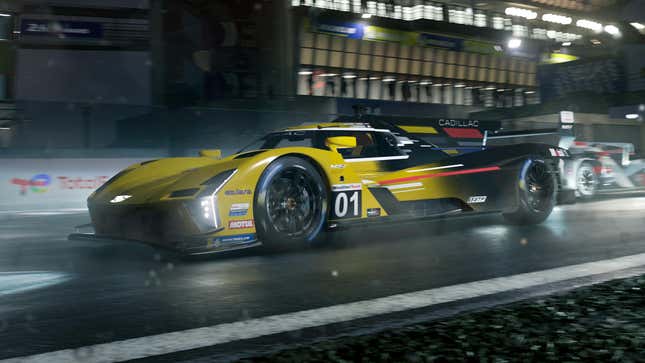Forza Motorsport and I go way back. The series is my benchmark simcade, the measuring stick against which all other racing games — from Gran Turismo to iRacing — are judged. So when Turn 10 announced a new game, one that aimed to live forever, I was excited. I like the idea of spending $60 once, and gaming for the rest of my life.
The game’s preview build showed promise. The physics were much improved, the lighting was ray-traced, and the differences between cars were more pronounced than ever — even through a controller. So why, with all these advancements over its predecessor, does Forza Motorsport frustrate me so much?
(Full Disclosure: Microsoft wanted me to play the new Forza Motorsport, so the company provided access keys for both PC and Xbox One. My copy of the game also included add-on car packs, as well as a few cosmetic items gifted longtime Forza players as a thank-you for their patronage. I honestly don’t know whether those came from the review code, or from me having so many Forza games tied to my Xbox account.)

Forza Motorsport Might Be The Best First Racing Game...
When you first open Forza Motorsport, you’re treated to the highs of the game right off the bat. Gorgeous, sweeping turns in a Corvette E-Ray; rushing your way through the last laps of an endurance race in a push for the podium — the game truly shines when you’re just sitting in a car, pushing your way forward, feeling the traction through your fingers and watching the light play off the ray-traced cars on track. This, alone, makes a good racing game. But Turn 10 didn’t stop at good.
Rather than just let you drive the cars, Forza Motorsport wants to teach you how to tune them. More than any other game in the series, this new Motorsport is focused on car progression — modifying, tuning, and dialing in the setup on a singular chassis rather than stockpiling hundreds of factory-fresh sports cars. It’s an interesting dichotomy to draw with Gran Turismo: While the latter is eager to teach you all about automotive history, Forza wants to teach you to wrench.

Of course, tuning and modifying is nothing new to simcades. Even many of the options in Motorsport look like holdovers from earlier games or the Horizon series, from the multiple levels of horsepower-adding exhausts to the drift-tuned suspension. But Motorsport wants you to really investigate these mods, try and err your way through the build process until you’ve come out with a car that truly fits you. Better than that, a car you truly understand — Motorsport doesn’t just want you to slap on an adjustable rear swaybar because it makes a number go up in a chart, it wants you to fiddle around with that swaybar, to adjust it to fit your driving style. And, in the process, to better learn the effects of all those mods you’re adding.
The game does this by progression-gating mods based on a car’s level. The more time you spend behind the wheel, the more corners you ace and sections you master, the more you’re allowed to fiddle with its inner workings and suit it to your tastes. Simple things like exhausts, air intakes, and wheels come up early, while bigger changes like engine swaps stay locked away until later. By my math, K-swapping an Integra I’d purchased would have to wait until I’d turned about 100 laps of Lime Rock Park in the car.

All those laps, of course, are equally important to shaving down your lap times. We’ve all seen someone with more money for mods than actual driving skill, and no one wants to be That Guy — you, as a driver, need to be up to the same level as your car. This is again helped by Motorsport’s progression gating, as none of your cars will get truly fast until you’ve turned enough laps to get your bearings, but the game goes further than that in teaching you how to drive.
Forza Motorsport breaks down its tracks into sections, rating your driving line through each one. It’s not perfect — the game doesn’t seem to dock you any points for following the right line in the wrong gear — but the system helps you track your improvement lap by lap. I can take a line I think feels good through the Toe of the Boot at Watkins Glen, only to find out that I’ve scored a mere 8.4 out of 10 — plenty of room for improvement in my approach to the corner. I always forget just how much it tightens up as you climb that hill.
For beginners, these features — progression-gated mods and track section ratings — can be a massive boon when learning how to race. They fit the game’s ethos of turning gamers into car enthusiasts, giving them a sense of how vehicles really work and making the obtuse intricacies of engineering more intelligible. And maybe, just maybe, we’ll start seeing more people make the jump from Xbox to HPDE.

...But For Returning Players, It Can Be Frustrating
Both of those beginner-oriented features, however, start to show their rough edges in the hands of longtime players and car enthusiasts. The progression gating on mods, which helps beginners get a feel for how their changes affect the car, gets in the way of power users who’ve already decided on stalwart tunes. After 780 hours in various Forza games, I know how I like my Integras to feel. Having to turn lap after lap, grinding out points just to access a new tire compound, doesn’t feel rewarding the same way it might for a novice. When you’re used to a buffet of options right from the jump, this new ladder just feels limiting.
The section ratings, too, feel tuned for beginners. On tracks like Lime Rock or Watkins Glen, tracks I’ve been around and know like the back of my hand in real life, I can routinely nail 10-out-of-10 section scores. On Lime Rock, with a little practice, I managed to link perfect scores in every section — theoretically, this should mean I’ve gotten the fastest lap time physically possible in my little Integra Type R. Yet I can hear the tires crying out when I brake too hard into Big Bend, I can feel the car huff and puff as I climb the uphill in fourth rather than third. I know there’s a better time in this car, but the point system isn’t helping me figure out where on the track those tenths are easiest to find. A perfect score here doesn’t mean the section’s been navigated perfectly, and that makes eking out the finer bits of driver improvement a struggle.

At its best, Forza Motorsport feels like a patient little league coach. Beginners start out playing tee ball with stock cars, and they’re given every bit of helpful feedback possible — always encouraging, always framed as a positive. The UI is as helpful as a game can be, showing granular times within key sections to tell you whether a given corner entry is faster or slower than your best, but the ball stays on the tee. You’re new here, you’re not ready to start hitting pitches. For novices, that’s probably smart.
But for experienced players, accustomed to showing up and hitting inter-office softballs thrown by those cheaters from the Poughkeepsie office, Motorsport can feel like being told to compete in that same tee ball game. You may know how to hit a pitch, you may be globally ranked for your ability to do so, but that ball isn’t leaving the tee until you prove you can do it, mister. And when you do, time and time again, you’re rewarded with the gentlest of lobs from a kneeling coach.
Forza Motorsport has a great physics engine. It’s largely a beautiful game (though crowds still leave something to be desired), and its campaigns are a genuinely interesting take on simcade progression. But for a game so focused on building, tuning, and modifying cars, it feels limiting in what it actually allows you to do. I want to race my friends in Motorsport, I want to lap A Class builds around the Glen while talking trash on Discord, but I don’t want the hours of grind it’ll take me just to unlock the parts I want. Forza Motorsport feels so good to play, I’m constantly looking forward to the good times I’ll have after its release — only for those dreams to be dashed on the rocks of gated progression.
Forza Motorsport releases October 10, and is available to pre-order now.